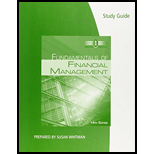
Concept explainers
a.
To determine: Theaverage expected inflation rate.
Expected Inflation Rate:
The expected inflation rate is the rate at which the price is expected to increase over the time, which results in fall of the purchasing value.
Nominal Rate of Interest:
The nominal rate of interest is the annual rate which is charged on the securities. The nominal annual rate is converted into effective annual rate to compare the rates of two different banks.
b.
To determine: The average nominal interest rate.
c.
To determine: The interest rate in January 1981 on the bonds that has its maturity in 1,2, 5, 10 and 20 years and draw a yield curve on these data.
d.
To explain: The general economic conditions that can lead to an upward sloping yield curve.
e.
To determine: The shape of the yield curve in the given situation and the factors affecting the curve.
Trending nowThis is a popular solution!

Chapter 6 Solutions
Study Guide For Brigham/houston's Fundamentals Of Financial Management, 14th
- critically discuss the hockey stick model of a start-up financing. In your response, explain the model and discibe its three main stages, highlighting the key characteristics of each stage in terms of growth, risk, and funding expectations.arrow_forwardSolve this problem please .arrow_forwardSolve this finance question.arrow_forward
- solve this question.Pat and Chris have identical interest-bearing bank accounts that pay them $15 interest per year. Pat leaves the $15 in the account each year, while Chris takes the $15 home to a jar and never spends any of it. After five years, who has more money?arrow_forwardWhat is corporate finance? explain all thingsarrow_forwardSolve this finance problem.arrow_forward
 EBK CONTEMPORARY FINANCIAL MANAGEMENTFinanceISBN:9781337514835Author:MOYERPublisher:CENGAGE LEARNING - CONSIGNMENT
EBK CONTEMPORARY FINANCIAL MANAGEMENTFinanceISBN:9781337514835Author:MOYERPublisher:CENGAGE LEARNING - CONSIGNMENT

